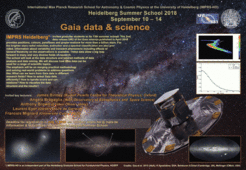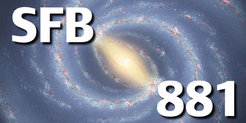Gaia Data & Science
The 13th Heidelberg Summer School took place September 10-14, 2018 at the Mathematikon in Heidelberg, Germany
Organization:
IMPRS for Astronomy and Cosmic Physics at the University of Heidelberg:
Max Planck Institute for Astronomy, Max Planck Institute for Nuclear Physics, Astronomisches Rechen-Institut, Institute for Theoretical Astrophysics, Landessternwarte Koenigstuhl, Heidelberg Institute for Theoretical Studies.
The school was also supported by the SFB 881 'The Milky Way System'.
Scientific organizing committee: Andreas Just & Stefan Jordan (ARI).
Invited lecturers:
James Binney (Rudolf Peierls Centre for Theoretical Physics, Oxford)
Angela Bragaglia (INAF-Observatory of Astrophysics and Space Science)
Anthony Brown (Leiden Observatory)
Laurent Eyer (Observatoire de Geneve)
Francois Mignard (Universite Cote d'Azur)
Scope of the school:
The goal of the school was to introduce the utilisation of Gaia data in different scientific fields including hands-on and excercises with the real data of the first full Gaia data set DR2 (published in April 2018). We liked to bring together five external teachers and a few locals to present different aspects of the scientific application of the data.
The second data release DR2 of Gaia provides positions, colours, parallaxes and proper motions for more than a billion stars. For the brighter stars radial velocities, extinction and a spectral classification are also provided. Additional information about variability and transient phenomena including the effect of General Relativity on the observations is available. These data allow a big leap forward in many and very diverse fields of research.
The school did look at the data structure and tailored methods of data analysis and data mining. We discussed how Gaia data can be used for a range of scientific topics. The emphasis of the summer school was on merging practical methodology and solving real-world problems to address questions like: What can we learn from Gaia data in different research fields? How do we select Gaia data efficiently for a given problem? How should we handle errors and correlations? How can we visualize the structure of data and the results?
Topics that were covered include:
- Gaia DR2 data structure and analysis tools
- Reference system and general relativity
- Dynamical models of the Milky Way disc
- Star clusters, Gaia-ESO survey and cluster ages
Material:
Have a look to the school program, the list of participants, the lecture notes (pw-protected), and the school gallery. You may also want to check a few useful Gaia links.


.

